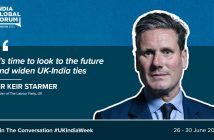New Delhi’s ambitious aims to develop ICT-enabled urban developments, or “Smart Cities”, with modern infrastructure across India with its relatively small $1.2 billion seed money could, according to a recent UK government report, create a market place worth almost $450 billion. Many experts suggest this is a conservative estimate.
Unsurprisingly, media and stakeholder attention has tended to focus on the potential economic rewards in building these cities. However, ‘bricks & mortar’ investment without human development and effective governance model, more often than not leaves behind white elephants rather than vibrant urban living spaces.
The importance of the human angle is even more key in the Indian context, where, according to research, each and every minute 30 Indians are migrating from rural areas to urban developments. With 70 per cent of Indians lacking
education beyond primary level, it is no surprise that these migrants, often rural agrarian workers, lack the skillsets to successfully contribute to a 21st century knowledge economy. They end up competing for the lowest paid jobs in the cities without any support network to help them integrate with the urban environment. As a result, wages get depressed leading to a wider group of people being left behind and inequality gets starker in Indian cities.
To its credit, the Narendra Modi led government’s idea of “smart cities” is an embodiment of its raison d’etre – “sabka sath sabka vikas” – where it aims to view the mass migration to cities as one more untapped potential to help create knowledge economy hubs around the country, developing competitive advantages based on their unique strengths powered by a high skilled workforce. And it is not just rhetoric – it has truly embraced this daunting challenge.
The government’s key policy programmes ranging from National Skills Development, financial inclusion, housing to more economically driven agenda such as Make In India, Ease of Doing Business and even Renewable Energy policies culminate in the microcosm of smart cities.
At its very core lies the need for effective delivery for all sections of society ranging from the tech entrepreneur to the unskilled migrant worker, through integrated public services and creating the appropriate support infrastructure to address housing, transport, education, health, economic development and environment.
Allocating resources to the right level of government, be it state or local level, to ensure locally-adapted and innovative set of interventions is another strand to New Delhi’s integrated approach of governance. The Prime Minister and his cabinet envisions effective implementation of its policies would lead to greener more cohesive communities with improved quality of opportunities and life for all the citizens and not just the few.
In this edition of the ‘India Investment Journal’, we take a microscopic look at this aspirational programme and how it has caught the imagination of the world. The investment is pouring into various aspects that go into making an Indian city truly smart.
Besides, of course, we delve into updates on other key programmes as India registers an impressive jump in its Ease of Doing Business ranking with the World Bank.
Read on for your latest investment update on India.
Manoj Ladwa is the founder of India Inc. and chief executive of MLS Chase Group @manojladwa







